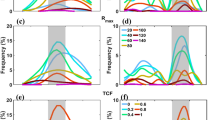Abstract
A 28-year best track dataset containing size parameters that include the radii of the 15.4 m s−1 winds (R15) and the 25.7 m s−1 winds (R26) of tropical cyclones (TCs) in the Northwestern Pacific, the NCEP/NCAR reanalysis dataset and the Extended Reconstructed Sea Surface Temperature (ERSST) dataset are employed in this study. The climatology of size parameters for the tropical cyclones in the Northwestern Pacific from 1977 to 2004 is investigated in terms of the spatial and temporal distributions. The results show that the major activity of TCs in the Northwestern Pacific is from July to October. A majority of TCs lie over the ocean west of 150°E, and a few TCs can intensify to the Saffir-Simpson (S-S) categories 4, 5. Both R15 and R26 tend to increase as the tropical cyclones intensify. The values of R15 and R26 are larger for intense TCs in the Northwestern Pacific than in the North Atlantic generally. Both R15 and R26 peak in October, and before and after October, R15 and R26 decrease, which is different from the case in the North Atlantic. The smaller R15s and R26s occur in a large range over the Northwestern Pacific, while the larger R15s and R26s mainly lie in the eastern ocean from Taiwan Island to the Philippine Islands where many tropical cyclones develop in intense systems. The tropical cyclones with size parameters of R15 or R26 on average take a longer time to intensify than to weaken, and the weak tropical cyclones have faster weakening rates than intensification rates. From 1977 to 2004, the annual mean values of R15 increase basically with year; during the 28-year period, the value of R15 increases by 52.7 km, but R26 does not change with year obviously.
Similar content being viewed by others
References
Brand, S., 1972: Very large and very small typhoon of the Western North Pacific Ocean. J. Meteor. Soc. Japan, 50(4), 332–341.
Chen Lianshou, and Liu Shikuo, 1997: A preliminary analysis on mechanism of size change in tropical cyclone. Journal of Tropical Meteorology, 13(2), 105–111. (in Chinese)
Cocks, S. B., and W. M. Gray, 2002: Variability of the outer wind profiles of western North Pacific typhoons: Classifications and techniques for analysis and forecasting. Mon. Wea. Rev., 130, 1989–2005.
Conover, W. J., 1999: Practical Nonparametric Statistics. 3rd ed., John Wiley and Sons, 218pp.
DeMaria, M., 1996: The effect of vertical shear on tropical cyclone intensity change. J. Atmos. Sci., 53, 2076–2087.
Duan Yihong, Wu Rongsheng, Yu Hui, Liong Xudong, and Johnny C. L. Chan, 2004: The role of β-effect and a uniform current on tropical cyclone intensity. Adv. Atmos. Sci., 21(1), 75–86.
Frank, W. M., and E. A. Ritchie, 2001: Effects of vertical wind shear on hurricane intensity and structure. Mon. Wea. Rev., 129, 2249–2269.
Gray, W. M., 1985. Tropical cyclone global climatology. WMO Technical Document, WMO/TD-No. 72, Vol. I, WMO, Geneva, Switzerland, 3–19.
Holland, G. J., and R. T. Merrill, 1984: On the dynamics of tropical cyclones structural changes. Quart. J. Roy. Meteor. Soc., 110, 723–745.
Kimball, S. K., and M. S. Mulekar, 2004: A 15-year climatology of North Atlantic tropical cyclones. Part I: Size parameters. J. Climate, 17, 3555–3575.
Landsea, C. W., 1993: A climatology of intense (or major) Atlantic hurricanes. Mon. Wea. Rev., 121, 1703–1713.
Merrill, R. T., 1984: Comparisons of large and small tropical cyclones. Mon. Wea. Rev., 112, 1408–1418.
Wang, Y., and C.-C. Wu, 2004: Current understanding of tropical cyclone structure and intensity changes—A review. Meteor. Atmos. Phys., 87, 257–278.
Weatherford, C. L., and W. M. Gray, 1988a: Typhoon structure as revealed by aircraft reconnaissance. Part I: Data analysis and climatology. Mon. Wea. Rev., 116, 1032–1043.
Weatherford, C. L., and W. M. Gray, 1988b: Typhoon structure as revealed by aircraft reconnaissance. Part II: Structural variability. Mon. Wea. Rev., 116, 1044–1056.
Author information
Authors and Affiliations
Rights and permissions
About this article
Cite this article
Yuan, J., Wang, D., Wan, Q. et al. A 28-year climatological analysis of size parameters for Northwestern Pacific tropical cyclones. Adv. Atmos. Sci. 24, 24–34 (2007). https://doi.org/10.1007/s00376-007-0024-y
Received:
Revised:
Issue Date:
DOI: https://doi.org/10.1007/s00376-007-0024-y



